Welcome to How to Resist, a blueprint for resistance based on nonviolence, mutual aid, and community building for ordinary people who want to save democracy.
Content warning, first two paragraphs: sexual assault, rape
Dear Resisters,
In 2014, a 19-year-old mother and asylum-seeker from Honduras, imprisoned at the Berks County Residential Center and Immigration Family Center in Berks Co., Pennsylvania, was repeatedly raped by a staff member. The staff member was convicted of seven counts of “institutional sexual assault” and sentenced to five months in prison, which is less time than the victim herself was detained.
Up until this point, ‘Berks’ had operated quietly out on County Welfare Road, for the most part out of sight and out of mind of the local residents. When the story broke of the assaults, horrified residents started paying attention to what was happening over at the residential center. In the following months, organizers, lawyers, immigrant leaders, faith leaders, and allies came together and created the Shut Down Berks Coalition. What followed was eight years of coalition building, nonviolent protest, civil disobedience, legal advocacy, and political pressure that spanned three presidencies until finally in 2023, Berks County Residential Center was closed for good.
“It is the best news I have heard. [I am] happy to know that there will never again be families in Berks Detention. No more depressed children locked up. Freedom is the most valuable thing that can be had […] Families should not arrive to be confined, no matter where they are from.” -Lorena, a mother who was incarcerated with her son at Berks for two years
The people who fought to shut down Berks were ordinary people. Many of them were immigrants themselves and former detainees still experiencing the effects of trauma from their and their children’s detentions. Nevertheless, they organized. Their strategy, tactics, persistence, and commitment to nonviolence ultimately achieved their goals, but their success offers more than inspiration; it offers us a blueprint for taking action against ICE detention centers.
Currently, there are more than 133 immigration detention centers operating in the United States. Earlier this month (May 2025), Human Rights First and Refugees International released the results of an in-depth investigation that exposes a pattern of human rights violations committed by U.S. immigration authorities, including enforced disappearances, denial of asylum, children and families held in inhumane conditions, medical neglect and psychological abuse, and the unlawful transfer of asylum seekers to third countries. Drawing on firsthand interviews, legal analysis, and field research, the report reveals how U.S. policies have systematically undermined legal protections and inflicted severe harm on vulnerable individuals and families seeking refuge, amounting to what Christina Asencio, Director of Research and Analysis at Human Rights First calls, “a humanitarian and legal crisis.”
As detention centers continue to operate across the country, often in secrecy and with little oversight, the tactics used to challenge Berks can guide today’s efforts to challenge US immigration policy and practices.
So, now, let’s talk about HOW.
M-.
I wouldn’t be able to commit to this work without the financial support of our paid subscribers. Thank you for allowing me to keep this content freely and publicly available for everyone who needs it.

1. Power Mapping
Every detention center is held in place by a web of power: local governments, private contractors, federal agencies, and funding sources. The first step is to untangle that web. Who owns the facility? Who profits from it? Who has the authority to shut it down? At Berks, activists identified key decision-makers at the county and state level, including the Pennsylvania Department of Human Services, members of congress, even appealing to the president. We must understand the structures of power if we are to effectively dismantle them.
2. Coalition Building
“We went door to door to connect with our neighbors”—Adrianna Torres-Garcia
The Shut Down Berks Coalition brought together a wide range of allies: local residents, immigrant leaders, immigration advocacy groups, faith communities, and legal organizations.
A good place to start building your coalition is Detention Watch Network, a national network that includes formerly detained people and their families, community and faith-based groups, legal service providers, lawyers, national and regional advocates and organizers, and law school clinics. They maintain a list of member organizations internationally, nationally, by region, and by state.
3. Centering Voices of the Detained
“When we were able to communicate with [the women detained at Berks], they would be part of making strategy decisions just like every other coalition member who wasn’t incarcerated. It was really important to us to make sure that whatever we were doing was grounded in the wishes and desires of people who were incarcerated and trying to not speak for them. Because they have a voice—all they needed was a platform.” — Adrianna Torres-García, deputy director of The Free Migration Project
Throughout the campaign, the coalition intentionally centered the voices of immigrants, especially women, detained at Berks. Centering the voices of detained individuals ensures our campaigns are grounded in truth and lived experience, making them more accurate, effective, and morally compelling. It affirms the agency of those most impacted, challenges dehumanizing narratives, and builds long-term leadership within immigrant communities. Following the lead of those who are most affected will guide our efforts toward more just, strategic, and sustainable outcomes.
“We took their lead [because] they knew what they needed,” —Tonya Wenger, Shut Down Berks Interfaith Witness
4. Establishing a Core Set of Values
“The values of the coalition are abolitionist, so it was always ‘shut it down.’ It was never, ‘make conditions better.’ And I think that hammering down on that message consistently throughout all these years was really what got us this win. When it looked like things were going roughly, and that there was no way to close it down, we would refer back to those values, and they would ground us.” Adrianna Torres-García, Free Migration Project.
The Shut Down Berks Coalition was abolitionist from the start. Their demand was not to improve conditions or reform the system; it was to end it. Clarity and purpose will help keep efforts on track and united towards a common goal, but it will also sustain a movement when victories are slow and setbacks are inevitable. Shared values can become the foundation that helps keep our efforts rooted and resilient.
5. Nonviolent Action & Civil Disobedience
“We basically tried everything.” — Tonya Wenger, Shut Down Berks Interfaith Witness
Protesting on a symbolic day
On International Women’s Day, 2022, the coalition gathered outside the detention center to protest the incarceration of migrant women and children, connecting the struggle for immigrant justice to broader feminist movements.
Protesting in a symbolic location
In 2021, activists protested the continued operation of the Berks in front of Independence Hall, Philadelphia, the birthplace of both the Declaration of Independence and the U.S. Constitution and the location of the Liberty Bell. By rallying at Independence Mall, the coalition was able to send a powerful message: incarceration of immigrant families stands in direct contradiction to the values this country was founded on. True freedom must include everyone, regardless of where they were born.

“We believe that no one should be incarcerated for being a migrant.” - Adrianna Torres-García of the Free Migration Project
Art & Storytelling
Art also has a powerful role in the resistance. Artist and filmmaker Michelle Angela Ortiz led a project where over 1,600 paper flowers, each bearing messages of freedom from detained families, were arranged into 10-foot-tall letters spelling “LIBERTAD” (freedom), which was installed at Philadelphia’s City Hall.

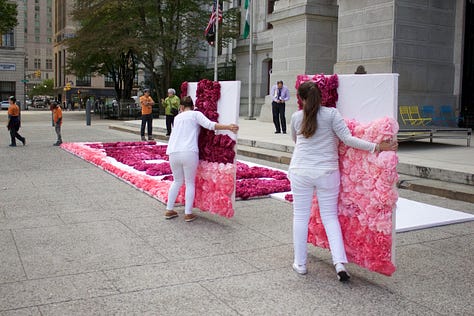
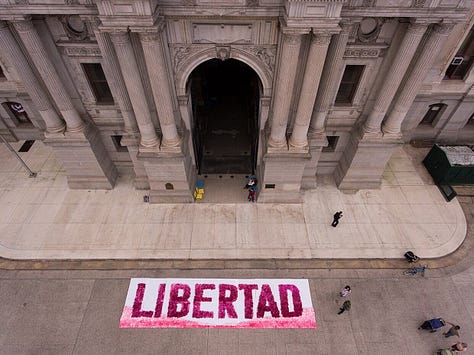
Michelle Angela Ortiz also created the documentary “Las Madres de Berks” (The Mothers of Berk) to amplify the voices of four mothers were detained for two years with their children. The film was at one point projected onto City Hall in Philadelphia as part of Ortiz’s exhibit on immigrant justice.
Hunger Strike
In 2016, twenty-two migrant women detained at Berks launched a hunger strike to protest their prolonged detention and the psychological toll it was taking on them and their children. Many of the women had been held for over a year, despite having passed initial asylum screenings. In a letter to Homeland Security officials, they demanded their release and an end to the practice of detaining families, stating that their indefinite confinement was inhumane and retraumatizing. The strike drew national attention and inspired similar actions at other family detention centers and underscored the desperation and courage of those incarcerated.
“I have been here for 320 days. […] What we want is for our voices to be heard.”
— Amparo Osorio, 26, detained at Berks with her 2-year-old son

School Strike
Children detained at Berks also took action. In 2016, they organized a school strike, refusing to participate in classes as a form of protest against their confinement. Children at Berks, who at that time ranged in age from 2 to 16, were divided into two classrooms, but were not allowed to attend outside school. According to the New York Times, the families had access to outdoor recreation, but were prohibited from going outside a wooden fence. They were permitted to use the internet, but social media was not allowed.
Work Stoppage
In 2015, ten mothers detained at the Berks launched a work stoppage to demand freedom for their children and the closure of the facility. At Berks, detainees were required to clean the facility themselves, receiving just $1 a day for their labor. This act of resistance was a powerful rejection of the exploitation and dehumanization embedded in the detention system. It signaled that those inside were willing to risk retaliation to demand dignity and freedom.
Civil Disobedience
In 2016, thirteen protestors, mostly from Make the Road Pennsylvania, an immigrants rights group, were arrested outside the Pennsylvania State Capitol in Harrisburg while demanding that Governor Tom Wolf shut down Berks. The protesters sat chained together in the street in front of the statehouse and were arrested after they refused to disperse.
“It may have been an inconvenience for people for 10 or 20 minutes but there are mothers and kids in there (the Berks center) for more than a year.” — Tonny Vera, Make the Road Pennsylvania
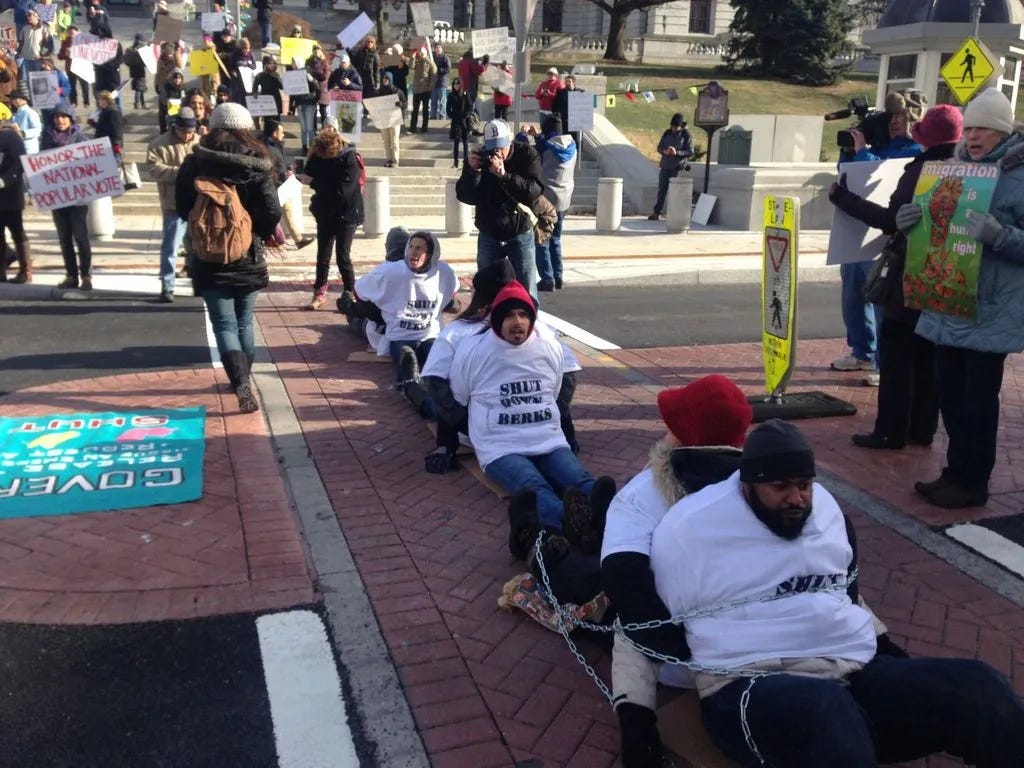
In 2018, a protest outside the Berks led to the arrest of 17 demonstrators. Around 200 people participated in the protest, and despite warnings from police, a group of protesters held a sit-in on the road outside the center, blocking traffic. The arrests were for “failure to disperse” and were part of a broader campaign of civil disobedience aimed at drawing attention to the inhumane conditions and unjust detention of families at Berks.
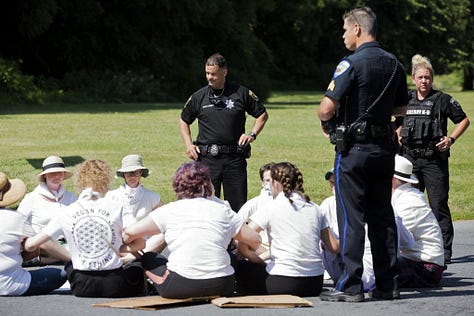
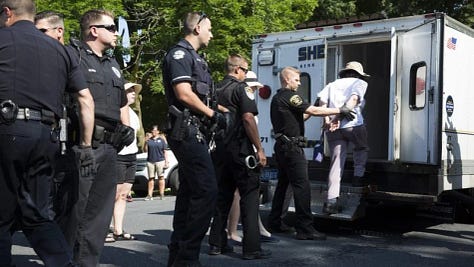

6. Political Pressure
“[We made a] commitment to being as annoying as possible to whichever decision–maker we thought might tip the scales in our favor.” —Andy Kang, Pennsylvania Immigration and Citizenship Coalition
In 2021, three Pennsylvania Congress members sent a letter to President Biden and the Department of Homeland Security Secretary Alejandro Mayorkas, urging them to immediately terminate the ICE contract held with the Berks County Residential Center.
Also in 2021, one hundred and forty five organizations signed a letter to the Biden administration demanding the permanent closure of Berks. The coalition also amplified the voices of those detained, sharing their stories through media, public testimony, and direct communication with policymakers.
In 2022, coalition members traveled to Washington, D.C., to demand that President Biden end the ICE contract with Berks.
“Whenever the President was in Pennsylvania, we would try to steal some of the media attention and at least insert the fact that immigrant detention is happening in Pennsylvania into the narrative.” — Andy Kang, Pennsylvania Immigration and Citizenship Coalition
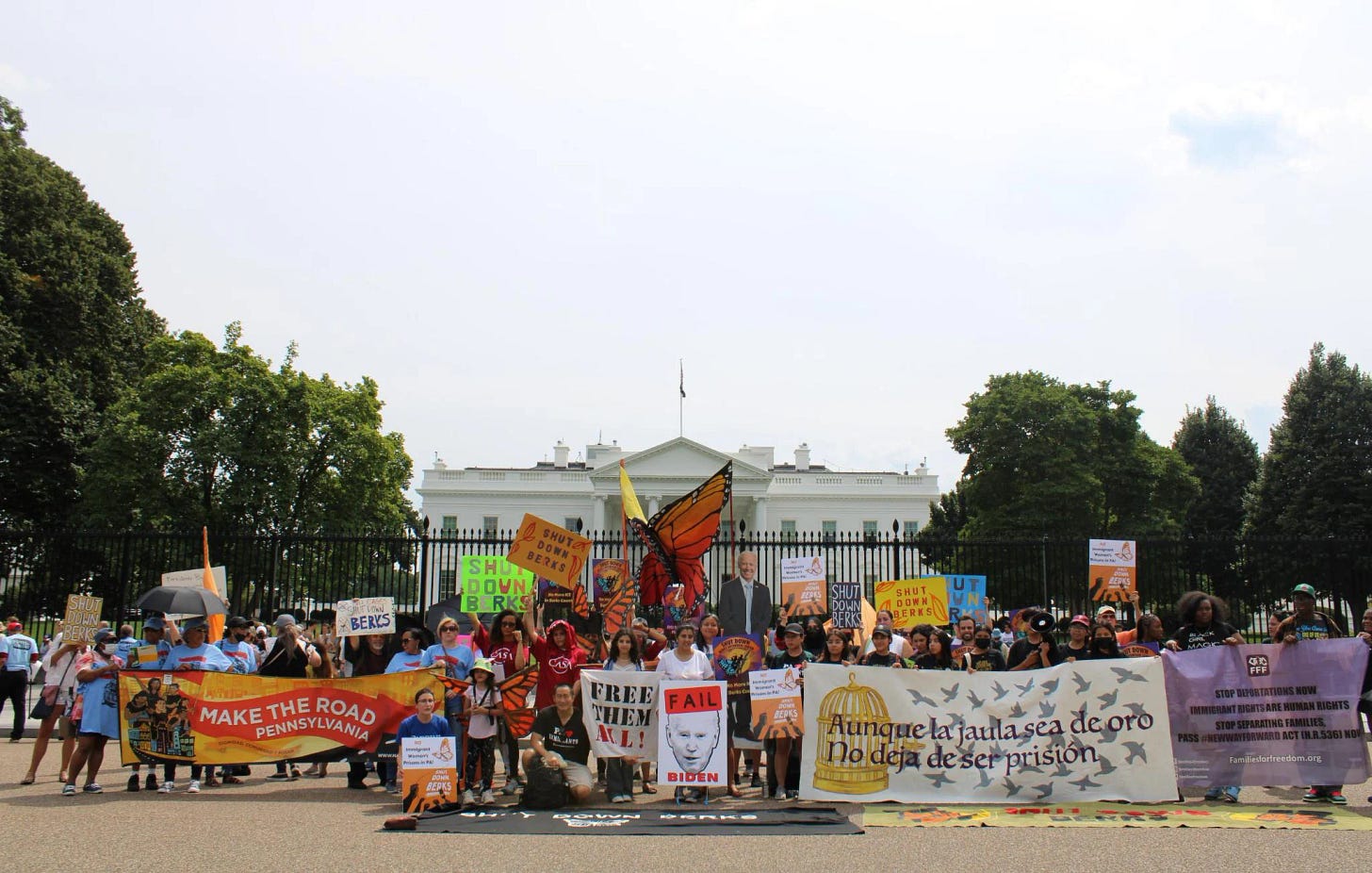
7. Legal Action
Legal action was another pillar of the campaign. The Free Migration Project and its partners filed multiple lawsuits in Pennsylvania courts, challenging the facility’s license and advocating for the rights of detainees. These cases helped build legal pressure that complemented the grassroots organizing.
Cases relating to this effort included:
Licensing case, Bureau of Hearings and Appeals, 2016
J.S.C. v. DHS, Commonwealth Court, 2019
C.N. v. DHS, PA Supreme Court and Commonwealth Court, 2020
Make the Road v. Leinbach, PA Commonwealth Court, 2021”
8. Creating the Future We Want
After Berks closed, organizers began working with local officials to repurpose the facility into something that serves the community: a substance use recovery center, a mental health facility, or a community hub.
“We have the chance to bring healing to our county after the years of harm this building was home to. It is vitally important that we repurpose this building and ensure that ICE never finds a home in Berks County again.” — Celine Schrier, Berks Stands Up
Thank you for reading, and I’ll see you on Sunday for our regular series, Good News from the Resistance! M-.
Support How to Resist
As a librarian writing in the service of democracy, I’m committed to keeping How to Resist free to read and publicly available for everyone; no paywalls, no gimmicks, no locked posts.
Currently, only 28 readers support this work through a paid subscription.
If this work matters to you and you’re able to support it, your paid subscription will help me keep publishing this content for everyone who needs it, for as long as it’s needed.
Prefer a one-time contribution? You can donate at ko-fi.com/howtoresist
References
After years of advocacy, ICE cuts the Berks County Detention Center contract—a huge win for the immigrant community. (2022, November 30). Detention Watch Network. https://www.detentionwatchnetwork.org/pressroom/releases/2022/after-years-advocacy-ice-cuts-berks-county-detention-center-contract-huge
Allyn, B., & Wisniewski, R. (2018, July 16). Berks County protests lead to arrests over detention center. WHYY. http://whyy.org/articles/berks-county-protests-lead-to-arrests-over-detention-center/
Berks County Detention Center Closes, Finalizing Eight-Year Campaign Led by PA Immigrant Community – We Are Casa. (n.d.). Retrieved May 20, 2025, from https://wearecasa.org/berks-county-detention-center-closes-finalizing-eight-year-campaign-led-by-pa-immigrant-community/
Berks County’s immigrant detention center is finally closed. The work isn’t over. (2023, January 31). Pennsylvania Capital-Star. https://penncapital-star.com/commentary/berks-countys-immigrant-detention-center-is-finally-closed-the-work-isnt-over-opinion/
Campaign to Shut Down Berks - Pennsylvania Immigration and Citizenship Coalition. (n.d.). Retrieved May 20, 2025, from https://web.archive.org/web/20231209173830/https://paimmigrant.org/campaign-to-shut-down-berks/
Chammah, M. (2015, April 17). Long Shorts and Baggy Shirts. The Marshall Project. https://www.themarshallproject.org/2015/04/17/long-shorts-and-baggy-shirts
Civic Engagement - Pennsylvania Immigration and Citizenship Coalition. (n.d.). Retrieved May 20, 2025, from https://web.archive.org/web/20231129025148/http://paimmigrant.org/civic-engagement/
Detention Facilities. (2020, September 17). https://www.ice.gov/detention-facilities
Harris, L. (2016, April 15). Berks Detention Center Employee Convicted of Sexual Assault of Young Honduran Mother. Immigration Impact. https://immigrationimpact.com/2016/04/15/berks-detention-center-employee-convicted-sexual-assault-young-honduran-mother/
Hughes, S. A. (2018, June 22). Why PA’s controversial Berks detention center for immigrant families is still open. Billy Penn at WHYY. http://billypenn.com/2018/06/22/why-pas-controversial-detention-center-for-immigrant-families-is-still-open/
Martinez, A. (2023, February 8). How the Shut Down Berks Coalition fought to close Berks County Detention Center. Prism. http://prismreports.org/2023/02/08/berks-county-detention-center-abolitionists-close/
Paik, J., & Hinchman, A. (2023, January 20). A Reverberating Victory: Shut Down Berks and the Fight for Immigrant Liberation. 34th Street. https://www.34st.com/article/2023/01/shut-down-berks-immigrant-prison-detention-center-coalition-migration-ice-facility
ReadingEagle. (2016, December 19). Demonstrators arrested demanding Wolf to shut down Berks detention center (VIDEO). Eagle. https://www.readingeagle.com/2016/12/19/demonstrators-arrested-demanding-wolf-to-shut-down-berks-detention-center-video/
Robbins, L. (2016, September 3). 22 Migrant Women Held in Pennsylvania Start a Hunger Strike to Protest Detention. The New York Times. https://www.nytimes.com/2016/09/03/nyregion/22-migrant-women-held-in-pennsylvania-start-a-hunger-strike-to-protest-detention.html
Shuey, K. (2022, March 8). Activists protest detention of female migrants at Berks facility on International Women’s Day. Eagle. https://www.readingeagle.com/2022/03/08/activists-protest-detention-center-berks-county/
“This is an Order from Trump”: Abuse, Expulsions, and Refoulement of People Seeking Asylum. (2025, May 8). Human Rights First. https://humanrightsfirst.org/library/this-is-an-order-from-trump-abuse-expulsions-and-refoulement-of-people-seeking-asylum/
Torres-García, A., & Rivera, J. (2023, January 31). A Victory for Abolitionists: ICE-Run Immigration Prison Shuts Down Today. Truthout. https://truthout.org/articles/a-victory-for-abolitionists-ice-run-immigration-prison-shuts-down-today/
Valentine, B. (2022, March 8). Shut Down Berks and others protest outside Berks Detention Center on International Women’s Day. Al Día News. https://www.aldianews.com/en/local/philadelphia/berks-not-women



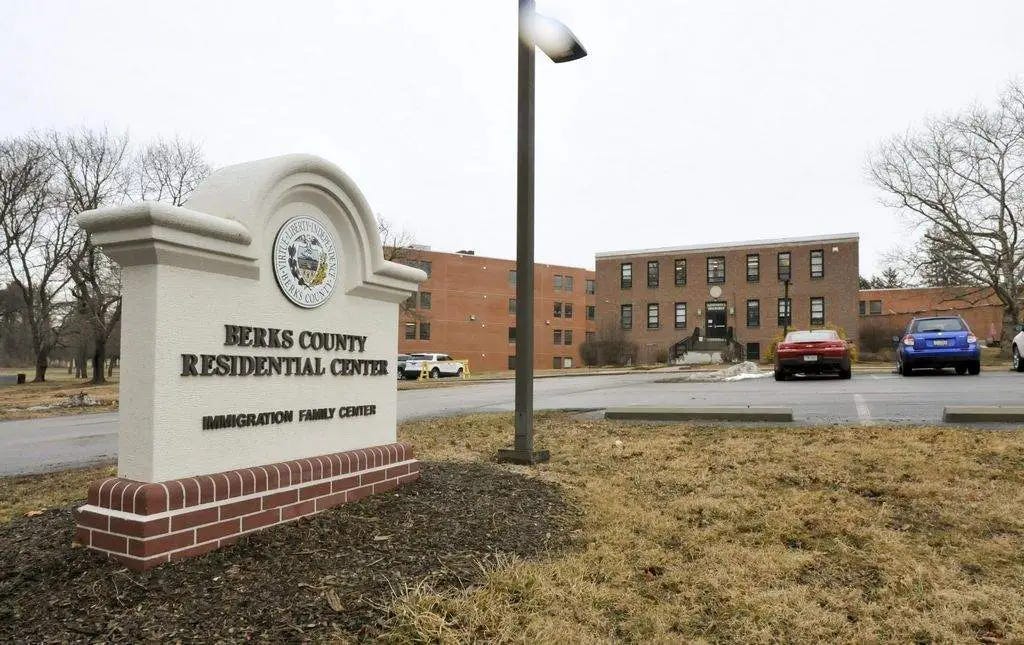


What an excellent blueprint! We can all do something to support this, for itself, and as part of the larger movement for freedom worldwide. Thank God, for those who are unwilling to take no for an answer, and for that guidance for how to get it done.
I like it. I am putting the names,places and abuses in my Substack daily